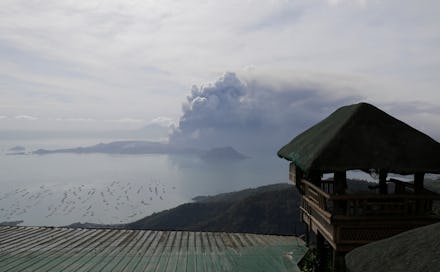The Philippines’ volcanic eruption could get worse

The Philippines may not be strangers to volcanic activity but that doesn't make it any less dangerous. On Sunday, one of the Philippines' most active volcanoes erupted in a plume of ash followed by lava flow. Although the eruption has been referred to as weak, officials are afraid that it could get worse.
Located in the Pacific Ring of Fire, the Philippines are home to 24 active volcanoes, which is defined as having erupted within the last 600 years. On the island of Luzon about 37 miles south of the capital Manila sits the Taal Volcano. It is responsible for the most recent eruption which sent ash nine miles into the air followed by thunder and lightning.
Originally, The Philippine Institute of Volcanology and Seismology (PHIVOLCS) issued a Level 3 alert for Taal. That was raised to Level 4, out of a maximum of 5, meaning that a "hazardous explosive eruption is possible within hours to days."
PHIVOLCS is calling for a total evacuation of Taal Volcano Island. It also urged people to evacuate from within a 17-kilometer radius from Taal Main Crater citing concerns over a volcanic tsunami.
So far, 30,000 people have been evacuated from Batangas and Cavite provinces, with many relocating to at least 28 evacuation centers nearby. And on Sunday, officials shut down Manila airport due to the ash-filled skies. However, CNN reported that a total of nearly 450,000 residents live within the volcanic danger zone.
You may not have heard about Taal until now but it's a unique volcano. Although it may be one of the world's smallest, the BBC reported that Taal has erupted at least 34 times in the past 450 years. It's also a complex volcano, meaning that it doesn't have a single cone or eruption point. Instead, it's made up of Taal Lake, the remnants of a massive, prehistoric volcano, and several islands.
Many people think of volcanic eruptions as short events like in movies, where the eruption itself may only last minutes. However, that isn't always the case, as Taal once erupted for nearly 7 months in 1754. Although that may seem like too long ago to matter, Taal repeating that historic eruption is always a possibility.
"We haven't seen yet the hazards of the 1965, 1911, and 1754 eruption manifested in Taal Volcano," PHIVOLCS Officer-in-Charge Renato Solidum told CNN Philippines. "[If it is a hazardous eruption], we will see flows of ashes, rocks, gas at speeds of more than 60 kph horizontally and that can move across the lake."
There is no way to predict what Taal will do next. Authorities will have to monitor the volcano and move quickly to keep residents appropriately alerted.